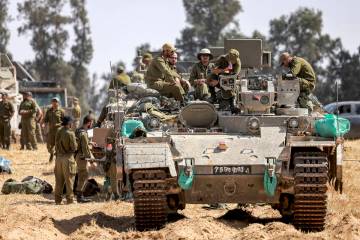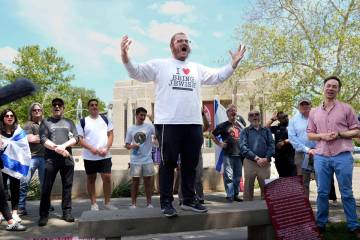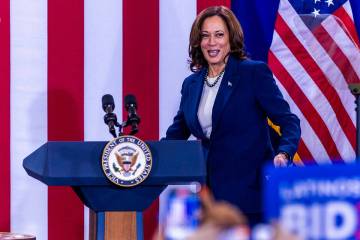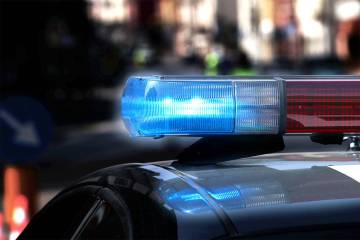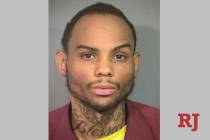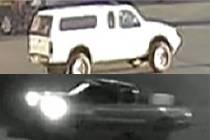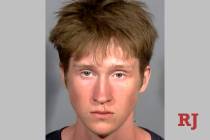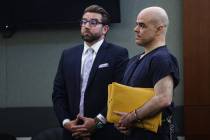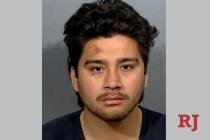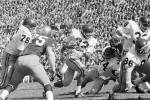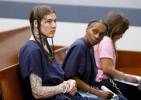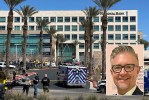Las Vegas police rank high in shootings
The Metropolitan Police Department uses deadly force at a higher rate than many other urban police agencies, according to a Review-Journal analysis that shows Las Vegas police could reduce shootings by preventing officers from placing themselves in situations where shooting is their only option.
Police in Clark County have killed 142 people in 378 officer-involved shootings since 1990, with Las Vegas officers involved in more than 80 percent. In dozens of incidents, officers had no choice but to use a gun. In others, use of deadly force could have been avoided.
The newspaper's analysis is based on thousands of pages of police reports, coroner's inquest transcripts, court files and other records, as well as interviews with police officers and law enforcement experts. Until now, debate over police shootings has focused on individual incidents rather than systemic issues that can determine when, where, how and why shootings happen.
Shootings by all Clark County police agencies were examined, but the analysis focused on the Metropolitan Police Department, the state's largest law enforcement agency and the center of controversy following two shooting deaths in 2010.
To determine if Las Vegas police use their guns more than those in other cities, the Review-Journal collected statistics for a decade, 2001 to 2010, from 16 cities. The Metropolitan Police Department ranked third in shootings by police per capita and per reported violent crime among those cities. In average annual shootings, Las Vegas police ranked fifth.
Other findings include:
■ Las Vegas police were involved in 310 shooting incidents since 1990, 115 of them fatal; North Las Vegas had 29, with 11 fatal; and Henderson had 22, 10 fatal. Twenty-one shootings, including eight fatalities, involved the Nevada Highway Patrol, Boulder City police, Clark County School District police or federal agents. Five shootings involved multiple agencies.
■ Shootings valleywide have generally increased over time, from just two in 1990 to a record 31 last year. From 1990 to 2000, there was an average of slightly more than 12 shootings per year. Since then, it's been more than 21 per year. While the valley's population has more than doubled in 20 years, the number of shootings has not been proportional — it varies greatly by year — and the number of shootings per capita in 2010 was nearly double that of each of the previous three, slow-growth years.
■ In 90 percent of incidents involving Las Vegas police, the shooting subject was armed, though not always with a gun. Cars were identified as a weapon in 16 percent of incidents. In a handful of cases shooting subjects were considered to be armed if they attempted to take an officer's weapon.
■ In 29 percent of Las Vegas police incidents, suspects fired guns at officers. An officer was injured in at least 10 percent of incidents.
■ Three officers in Clark County — North Las Vegas officer Raul Elizondo in 1995, Las Vegas police Sgt. Henry Prendes in 2006, and Las Vegas officer Trevor Nettleton in 2009 — were shot dead.
■ Shootings are considered rare for officers, but at least 13 percent of current Las Vegas cops have been involved in at least one shooting, a higher rate than Henderson and North Las Vegas police, each at about 8.5 percent.
■ Nine shootings by Las Vegas police involved off-duty cops whose actions were classified as officer-involved shootings because they were acting in a law enforcement capacity. Incidents unrelated to police work, such as a 1997 drive-by shooting by two off-duty Las Vegas officers, were not included.
■ Blacks, less than 10 percent of Clark County's population, account for about 30 percent of Las Vegas police shooting subjects. Moreover, 18 percent of blacks shot at by police were unarmed.
■ About 25 percent of shootings followed a foot pursuit; 17 percent involved a car chase. Six percent involved both.
■ Twenty percent of Las Vegas police shootings were into a vehicle.
■ At least 70 percent of those killed by police had drugs or alcohol in their system. At least half had arrest records.
■ Forty-two percent of all officer-involved shootings happened in just seven of Clark County's 136 ZIP codes: 89101, 89103, 89104, 89108, 89110, 89115 and 89121. They include downtown and areas east of downtown; neighborhoods near Nellis Air Force Base; an area south of Spring Mountain Road and west of Interstate 15; and an area between Rancho Drive and Buffalo Drive north of Washington Avenue. Most are lower-income areas with a high proportion of rental housing. Each had at least 20 police shootings.
COMPARATIVELY HIGH RATE
Discussion of police shootings in Las Vegas in recent years has been long on speculation, if short on detail. Because there's no national clearinghouse for that data, there is no national average or even readily available city-by-city numbers.
"Even on the academic end, the studies of officer-involved shootings are relatively limited," said Bill Sousa, a criminology professor at the University of Nevada, Las Vegas.
To compare shooting rates among U.S. police departments, the Review-Journal sampled the nation's 20 largest municipal police agencies, based on population served, plus Denver, Seattle, and Portland, Ore., for geographical balance. The survey also took into account violent crime rates, one indicator of how likely officers are to encounter a situation calling for use of deadly force. Sixteen agencies provided data for 2001 to 2010.
The Metropolitan Police Department ranked third, behind Houston and Chicago, in officer-involved shootings per capita. It also ranked third in shootings per reported violent crime, trailing Denver and Seattle.
Ronnie Dunn, an urban studies professor at Cleveland State University who has researched officer-involved shootings in Cleveland, reviewed the newspaper's findings and concluded "there is clearly reason for concern regarding the volume and increase in police-involved shootings over the past 20 years."
He singled out the disproportionate rate at which Las Vegas police shoot black subjects and in-vehicle shootings as particular areas of concern.
Asked whether he thinks his department uses deadly force more often than others, Clark County Sheriff Doug Gillespie said he's never seen reliable data to allow a comparison to other departments.
"I've always said that one officer-involved shooting is too many," Gillespie said. "Whatever we can do to prevent those acts from occurring, we have an obligation to do."
Gillespie's predecessor, Bill Young, said much the same.
"I will freely admit that we have a lot of shootings here in Southern Nevada. More than what I'd like, and more than almost all our citizens and more than most police officers obviously like," said Young, a 29-year police veteran and sheriff from 2003 to 2007.
DANGEROUS JOB
Dozens of shootings analyzed by the Review-Journal were clearly unavoidable and necessary to protect the life of an officer or a civilian.
Take, for example, a shooting on April 28, 2001: Las Vegas police officer Keith Borders, just 30 months on the force, responded to a domestic disturbance on West Desert Inn Road, where he found Donald Charles Mettinger, 49, and his girlfriend, Susan Spaine, arguing.
While Borders was talking to Spaine across the street, Mettinger emerged from the house with two handguns and fired at backup officers, forcing them to retreat. He then fired a shotgun at Borders, who was shielding Spaine with his body. In the ensuing gunbattle, the severely injured officer fired 39 rounds from his .45-caliber handgun, hitting Mettinger eight times and killing him. Two years later Borders became the first police officer to receive the national Public Safety Officer Medal of Valor. After extensive surgeries he was forced to retire in 2005.
Las Vegas officers have been wounded in gunbattles at least 22 times since 1990. In at least 88 of the 310 incidents, officers said they were shot at before returning fire.
Authorities often say cops are more likely to encounter people with guns than in the past, but the analysis doesn't support that. The proportion of subjects with guns has been consistent at about half in each year since 1990, and the percentage who fired at officers has actually decreased since 2000.
In some cases it was clear the shooting subjects wanted police to kill them — a phenomenon called "suicide by cop." These incidents are few.
The newspaper identified a suicide by cop if a subject clearly communicated a desire to die, provoked a confrontation and did something to threaten officers. Only about 5 percent of shootings met this strict definition.
But in 11 incidents, a person committed suicide during a confrontation, in some cases choosing death over arrest. Those were classified as suicide, not suicide by cop.
PERCEPTION FAILS
At least 33 times since 1990 Las Vegas police have shot at an unarmed person. Seven, including one fatality, occurred in one recent 16-month period, September 2009 to January 2011.
In some of the 33 incidents, officers later said they felt the person was armed with a gun and was going to harm them or others. The Police Assessment Resource Center, a Los Angeles-based organization that studies law enforcement issues, refers to these as "state of mind" or "perception" shootings.
On occasion, the perceptions of Las Vegas officers are wrong.
On April 19, 2000, officer Nathan Chio stopped a car near Pecos Road and Las Vegas Boulevard because the registered owner was wanted on a felony parole violation. After ordering the driver, Kendrick Weatherspoon, out of the car, Chio, a four-year veteran cop, saw what he believed to be someone moving under a pile of clothes in the back seat. He shouted at the person to get out, and fired twice into the pile when something fell to the floor.
There was no one under the laundry.
The Las Vegas police Use of Force Review Board, which rarely faults officers in shootings, found that Chio violated department policy. Because of department personnel rules, it's unclear if he was disciplined. He is still on the force.
Weatherspoon, 33, still resents the shooting. He wasn't even wanted — the warrant was for the car's prior owner.
"My 5-year-old son could have been in the back seat," Weatherspoon said. "I never got an explanation for what (Chio) did. I never even got paid for the bullet hole in my car."
Wayne Peterson, a homicide lieutenant at the time, called the shooting one of the most troubling he ever saw.
"How could you shoot in a pile of clothes?'' he said. "Thank God nobody got hit."
Weatherspoon's extended family had other volatile encounters with police later that year. His cousin, Markus Weatherspoon, shot and injured a Las Vegas officer in June 2000, and his uncle, Johnnie Weatherspoon, was shot and killed by North Las Vegas police during a drug raid in August.
DIFFICULT DECISIONS
Nine times since 1990 Las Vegas police have shot and killed an unarmed man.
In several high-profile cases, including the 1999 death of John Paul Perrin, 32, and the troubling 2010 shooting of small-time marijuana dealer Trevon Cole, 21, an unarmed person was shot after making a movement that police perceived as threatening.
For every unarmed person shot at by Las Vegas police, nine had some kind of weapon, usually a gun. However, about half of the subjects armed with guns never fired a shot.
That was the case in one of the most controversial shootings in recent memory, when Erik Scott, 38, a medical device salesman, was killed as he left a crowded Costco store in affluent Summerlin on July 10, 2010.
Like 70 percent of those killed by police, Scott was under the influence of alcohol or drugs — heavy doses of prescription pain pills for a back injury. But he wasn't accused of any crime. A store employee thought he was acting strangely and dialed 911 when he saw that Scott, who had a concealed weapons permit, had a holstered gun and refused to leave the store.
Three Las Vegas officers — William Mosher, Thomas Mendiola, and Joshua Stark — said they fired because Scott didn't follow orders to get on the ground and instead pulled the still-holstered gun from his waistband. Inquest witnesses testified that Scott appeared dazed and may not have realized he was doing something that would be perceived as a threat. The shooting was ruled justified, but it still prompted debate about whether police could have resolved the situation without resorting to deadly force.
Sometimes the perception that a suspect is capable of doing great harm is validated by information learned only after a shooting.
On Sept. 30, 2006, Las Vegas police responded to a shots-fired call on the west side of the city. Officer Bradley Cupp and his partner tried to question two men who then led them on car and foot pursuits. Pierre Donte Joshlin, 18, pointed a handgun at Cupp, who responded by firing three rounds at him, all of which missed. Joshlin was later found hiding in a trash bin and was arrested. Cupp didn't know until later that the initial call stemmed from a murder committed by Joshlin and others.
BLACK AND WHITE
When it comes to officer-involved shootings, race and location matter.
Since 1990, 39 percent of Las Vegas shooting subjects were white, 32 percent black, and 26 percent Hispanic, as noted in the 92 percent of cases listing a race.
Hispanics are 29 percent of Clark County's population, so shootings for that group roughly followed local demographics. But blacks, at less than 10 percent, were dramatically overrepresented in several ways.
Of the 33 unarmed subjects shot at by Las Vegas police, about half were black, including five of the seven in those 16 months from September 2009 to January 2011.
Of the 77 Las Vegas shootings preceded by foot pursuits, nearly half involved black men.
"The numbers are obviously disturbing in terms of the issues it raises about police tactics used in different communities," said Richard Boulware, a member of the executive board of the Las Vegas chapter of the NAACP.
That's not unique to Las Vegas.
In a report on its own shootings, the Los Angeles County Sheriff's Department earlier this year wrote that "when there is a mistaken shooting of an unarmed individual, he or she has a substantially higher likelihood of being a young black or Latino person than a white or Asian."
Dunn said research in cognitive psychology shows when a person is ostensibly threatening an officer with a deadly weapon, the decision to shoot is made faster if the subject is black, and the decision not to shoot comes faster if the subject is white. He said the Review-Journal's data "might indicate a need for cultural awareness training as well as more thorough psychological screening in the recruitment and hiring of officers to test for biases, either conscious or unconscious."
David Klinger, a former Los Angeles cop who teaches criminology at the University of Missouri, St. Louis, said the Review-Journal's analysis mirrors other studies.
"Unfortunately, minorities are disproportionately shot by police, and we've known that forever," Klinger said.
Conversely, 27 percent of all shooting subjects armed with guns and 26 percent of those who shot at Las Vegas cops were black.
ON FOOT
Seventy-seven times since 1990, Las Vegas officers chased people on foot before shooting at them. That represents 24 percent of all shootings by the department.
By comparison, North Las Vegas police had foot pursuits in just four of 29 shootings; Henderson only once in 22 shootings.
While many large police departments restrict foot pursuits to reduce risk to officers and limit violent confrontations, Las Vegas police only this year implemented a chase policy — one that falls short of the standard set by the International Association of Chiefs of Police, which strongly discourages solo foot pursuits and requires officers to stop if they lose sight of their target or lose contact with their partner.
Many Las Vegas shootings after foot pursuits have been solo chases.
Gillespie said the new policy, while only advisory, has reduced foot pursuits: There have been just two so far this year.
But Gillespie also acknowledged chases have been an issue. He said some officers "get caught up in the heat of the moment" and forget their training.
The department allows officers to use deadly force to prevent the escape of a "fleeing felon" who poses a significant threat to human life, but in at least two chases Las Vegas officers put themselves and others in danger over jaywalking.
On Jan. 19, 2009, a jaywalking suspect in the 3000 block of Las Vegas Boulevard North ran from officer Danny Tapia, who was in his second year on the force. Tapia said he fired five shots — one each time the runner turned and pointed a gun at him without firing — but missed each time. The jaywalker got away and has never been identified.
About a year after that incident, Las Vegas gang officers tried to detain Ray Ivory, 22, and another jaywalker at Vegasgreen Trail and Owens Avenue. Ivory ran, and officer Ben Rose went after him. When Ivory pulled a gun, Rose fired three rounds, missing each time. Ivory didn't shoot, and later received probation after pleading guilty to resisting a public officer. Both shootings were ruled justified by the department's Use of Force Review Board.
MOVING VEHICLES
Sixteen percent of all Las Vegas shootings involved moving vehicles, making cars a more common "weapon" than knives, and in many ways more problematic. Six of the last seven shootings ruled unjustified by the Review Board involved vehicles.
In 2000, Sheriff Jerry Keller advised officers to stop shooting at cars, but incidents actually increased after that. There have been fewer incidents since 2002, but some of the department's most questionable shootings have continued to involve cars.
On Sept. 11, 2009, for example, Las Vegas officer Jesse Gerstel and his partner made a routine traffic stop on the Strip and ordered the driver, Erik Perez, 28, to turn off his engine. Instead, Perez drove off. Gerstel shot out the car's back window in an intersection crowded with pedestrians and other motorists.
Perez wasn't attempting to ram anyone with his car and no one was endangered. Gerstel, no longer with the department, admitted to investigators that he had violated policy; the shooting was ruled unjustified.
In some cases, officers needlessly put themselves in harm's way by reaching into cars or trying to block vehicles with their bodies. If the driver doesn't stop, the car is considered a weapon and the officer is justified in using deadly force for self-defense.
Gillespie acknowledged his officers had a problem with shooting into vehicles, but said it's being fixed. However, the department had four vehicle shootings last year and one so far this year.
MENTAL HEALTH
In 2003 Young instituted training to help officers better handle people who are suicidal or mentally ill. The program has won praise, but those Crisis Intervention Training officers might not have a significant effect on shootings.
Before 2003, about 14 percent of those shot at by police were identified as suicidal or mentally ill. Since then, the rate has been about 20 percent. It's not clear, however, if the numbers indicate limited success or point to a good program overwhelmed by a rising problem.
In half the incidents involving the mentally ill since 1990, shooting subjects were armed with knives.
Gillespie said officers respond to more calls involving the mentally ill than in the past.
"The services provided at the state and local level to people who are mentally ill have been reduced," Gillespie said. "That has impacted the percentage of the population we're engaged with day to day who are mentally ill."
Half of those shot by Henderson police since 1990 were experiencing a mental health crisis — more than three times the rate for Las Vegas police. Henderson Police Chief Jutta Chambers said she wants Crisis Intervention Training for all officers.
"There's a huge value in that," she said. "We're experiencing a lot more issues with folks who might have mental health problems."
SHOOTER, SUBJECT, CIRCUMSTANCES
Since 1990, 519 officers from all Las Vegas Valley departments have been involved in a shooting, including 413 Las Vegas police officers.
Las Vegas officers also dominate the list of 75 cops who have been involved in two or more shootings, with 66 names. Two officers share the record for number of shootings: Former Las Vegas officer James Breed and current North Las Vegas officer Michael Carmody.
Ninety-six percent of officers involved in shootings since 1990 were men.
There's been speculation that waves of hiring as Las Vegas boomed contributed to high shooting rates because more young, inexperienced cops were on the street, but nothing in the data shows that. On average, the officers involved in shootings were more than 30 years old and had more than six years of experience. In 2010 the averages were seven years and slightly older than 35.
The average age of a shooting subject was 30, and 92 percent were male. The youngest person shot by Las Vegas police was 13. The oldest was 77.
While police often cite Las Vegas' status as a 24-hour adult playground as a contributing factor in shooting rates, the analysis found that tourists seldom get involved. The overwhelming majority of those shot since 1990 had a local address.
A person killed by police was more likely to be under the influence of alcohol than any other drug. In the 2000s, however, methamphetamine was noted in toxicology reports for 25 subjects, up from nine in the 1990s.
Las Vegas police were involved in more shootings in the month of January than any other. Tuesday was the most frequent day of the week. There were more shootings, 31, between 10 p.m. and 11 p.m. than any other time of day. The fewest shootings, six, took place between 7 a.m. and 8 a.m. and from 3 p.m. to 4 p.m.
The majority of shootings started with calls for service, most frequently a domestic disturbance.
Las Vegas police officers used a stun gun, pepper spray or other nonlethal weapon in 11 percent of incidents where they also used firearms, and initially fought hand-to-hand in 8 percent.
Only one person was shot in more than one incident. Jeffrey Dean Martindale was wounded by Las Vegas police after a 1991 bank robbery and was killed in 2005 by Boulder City police after he fired at officers trying to arrest him for attempted murder. He was 32.
Two officers were involved in shootings with more than one department. Glenn Rector and Eric Seibold each used deadly force as Highway Patrol troopers and as Las Vegas cops.
Alan Maimon is a Review-Journal special correspondent.





